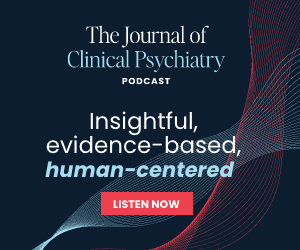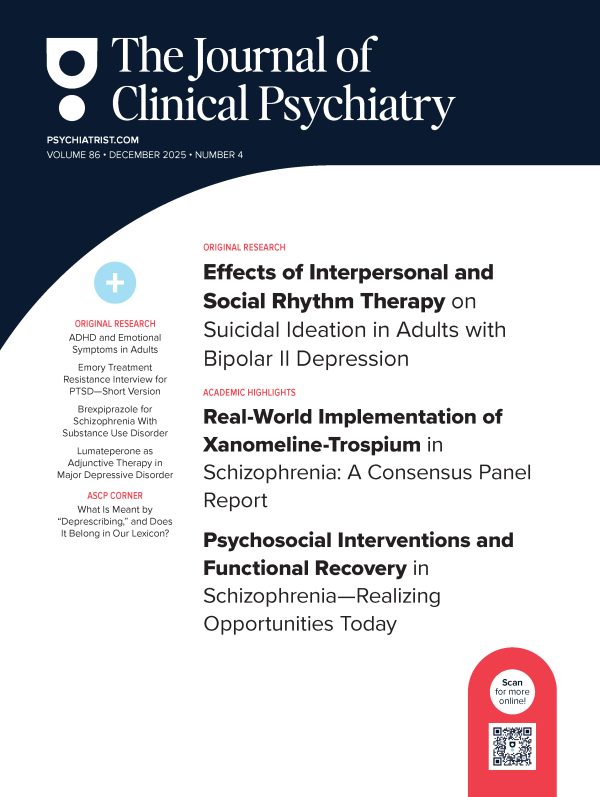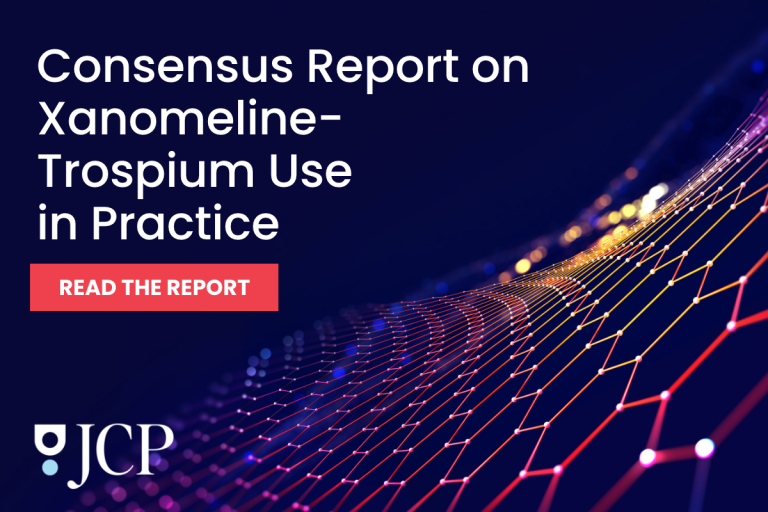Abstract
Objective: Both intravenous (IV) racemic ketamine and intranasal (IN) esketamine have emerged as rapid-acting antidepressants for treatment-resistant depression (TRD) and are increasingly used in clinical settings. Relatively few studies, however, have compared these interventions in larger, naturalistic cohorts. This study was conducted to assess the comparative efficacy and rapidity of response observed with repeated IV ketamine versus IN esketamine in a psychiatric neurotherapeutics specialty service. Through retrospective chart review, we conducted what is, to the best of our knowledge, among the larger such comparisons to date.
Methods: Data from 153 patients with severe TRD were reviewed (111 patients received IV ketamine and 42 patients received IN esketamine). In accordance with consensus criteria for TRD and validated objective criteria for illness severity, included patients failed a minimum of 2 adequate antidepressant treatment trials and demonstrated a preketamine treatment score of 16 or higher on the 16-item Quick Inventory of Depressive Symptomatology-Self-Report (QIDS-SR16). Severity of depression was subsequently reassessed with the QIDS-SR16 prior to each ketamine and esketamine administration. A 2-way analysis of variance was used to compare changes in QIDS-SR16 scores between the IV ketamine and IN esketamine treatment groups.
Results: With equivalent depression severity measured by QIDS-SR16 at pretreatment baseline, the IV ketamine treatment group showed significantly greater decreases in QIDS-SR16 scores compared to the IN esketamine group, as measured immediately before each treatment from the third to the eighth session (all P values < .05). Patients who received IV ketamine infusions demonstrated a 49.22% reduction in QIDS-SR16 scores by the eighth treatment, while patients who received IN esketamine over the same induction period showed a 39.55% reduction. As expected, both IV ketamine and IN esketamine treatments resulted in significant decreases in QIDS-SR16 scores. In the IV ketamine group, the decrease in QIDS-SR16 scores reached significance after 1 treatment, while in the IN esketamine treatment group, the decrease in QIDS-SR16 scores reached significance after the second treatment.
Conclusion: In this naturalistic sample of patients with similarly severe TRD treated in a ketamine subspecialty service over a 4–5-week induction period, treatment with IV racemic ketamine was associated with a more rapid response and greater overall efficacy than treatment with IN esketamine.
J Clin Psychiatry 2025;86(4):25m15789
Author affiliations are listed at the end of this article.
Members Only Content
This full article is available exclusively to Professional tier members. Subscribe now to unlock the HTML version and gain unlimited access to our entire library plus all PDFs. If you’re already a subscriber, please log in below to continue reading.
References (21)

- World Health Organization. Depressive Disorder (depression). World Health Organization. 2023. https://www.who.int/news-room/fact-sheets/detail/depression.
- McIntyre RS, Filteau MJ, Martin L, et al. Treatment-resistant depression: definitions, review of the evidence, and algorithmic approach. J Affect Disord. 2014;156:1–7. PubMed CrossRef
- Berlim MT, Turecki G. Definition, assessment, and staging of treatment-resistant refractory major depression: a review of current concepts and methods. Can J Psychiatry. 2007;52(1):46–54. PubMed CrossRef
- Berman RM, Cappiello A, Anand A, et al. Antidepressant effects of ketamine in depressed patients. Biol Psychiatry. 2000;47(4):351–354. PubMed CrossRef
- Caddy C, Amit BH, McCloud TL, et al. Ketamine and other glutamate receptor modulators for depression in adults. Cochrane Database Syst Rev. 2015(9):Cd011612. PubMed CrossRef
- Fond G, Loundou A, Rabu C, et al. Ketamine administration in depressive disorders: a systematic review and meta-analysis. Psychopharmacology. 2014;231(18):3663–3676. PubMed CrossRef
- Han Y, Chen J, Zou D, et al. Efficacy of ketamine in the rapid treatment of major depressive disorder: a meta-analysis of randomized, double-blind, placebo controlled studies. Neuropsychiatr Dis Treat. 2016;12:2859–2867. PubMed CrossRef
- McGirr A, Berlim MT, Bond DJ, et al. A systematic review and meta-analysis of randomized, double-blind, placebo-controlled trials of ketamine in the rapid treatment of major depressive episodes. Psychol Med. 2015;45(4):693–704. PubMed CrossRef
- Andrade C. Ketamine for depression, 4: in what dose, at what rate, by what route, for how long, and at what frequency?. J Clin Psychiatry. 2017;78(7):e852–e857. PubMed CrossRef
- Malhi GS, Byrow Y, Cassidy F, et al. Ketamine: stimulating antidepressant treatment? BJPsych Open. 2016;2(3):e5–e9. PubMed CrossRef
- Vande Voort JL, Morgan RJ, Kung S, et al. Continuation phase intravenous ketamine in adults with treatment-resistant depression. J Affect Disord. 2016;206:300–304. PubMed CrossRef
- Singh JB, Fedgchin M, Daly E, et al. Intravenous esketamine in adult treatment-resistant depression: a double-blind, double-randomization, placebo-controlled study. Biol Psychiatry. 2016;80(6):424–431. PubMed CrossRef
- Gutierrez G, Swainson J, Ravindran N, et al. IN Esketamine and IV ketamine: results of a multi-site observational study assessing the effectiveness and tolerability of two novel therapies for treatment-resistant depression. Psychiatry Res. 2024;340:116125. PubMed CrossRef
- Rodolico A, Cutrufelli P, Di Francesco A, et al. Efficacy and safety of ketamine and esketamine for unipolar and bipolar depression: an overview of systematic reviews with meta-analysis. Front Psychiatry. 2024;15:1325399. PubMed CrossRef
- Rush AJ, Trivedi MH, Ibrahim HM, et al. The 16-Item Quick Inventory of Depressive Symptomatology (QIDS), Clinician Rating (QIDS-C), and Self-report (QIDS-SR): a psychometric evaluation in patients with chronic major depression. Biol Psychiatry. 2003;54(5):573–583. PubMed CrossRef
- Dai D, Miller C, Valdivia V, et al. Neurocognitive effects of repeated ketamine infusion treatments in patients with treatment-resistant depression: a retrospective chart review. BMC Psychiatry. 2022;22(1):140. PubMed CrossRef
- Bahji A, Vazquez GH, Zarate CA Jr. Comparative efficacy of racemic ketamine and esketamine for depression: a systematic review and meta-analysis. J Affect Disord. 2021;278:542–555. PubMed CrossRef
- Nikayin S, Rhee TG, Cunningham ME, et al. Evaluation of the trajectory of depression severity with ketamine and esketamine treatment in a clinical setting. JAMA Psychiatry. 2022;79(7):736–738. PubMed CrossRef
- Singh B, Kung S, Pazdernik V, et al. Comparative effectiveness of intravenous ketamine and intranasal esketamine in clinical practice among patients with treatment-refractory depression: an observational Study. J Clin Psychiatry. 2023;84(2):22m14548. PubMed CrossRef
- McIntyre RS, Rosenblat JD, Nemeroff CB, et al. Synthesizing the evidence for ketamine and esketamine in treatment-resistant depression: an international expert opinion on the available evidence and implementation. Am J Psychiatry. 2021;178(5):383–399. PubMed CrossRef
- Niciu MJ, Meisner RC, Carr BR, et al. National Network of Depression Centers position statement: insurance coverage for intravenous ketamine in treatment-resistant major depressive disorder. J Affect Disord. 2024;346:221–222. PubMed CrossRef





